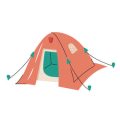1. Shake Out Debris and Clean Your Tent
Before you even think about folding up your tent, it’s crucial to get rid of all the dirt, leaves, and other debris that may have collected inside and outside during your camping trip. Start by turning the tent inside out or unzipping all doors and windows, then give it a good shake to dislodge any loose particles. Pay special attention to corners and seams where bits of grass or pine needles love to hide. If you spot mud or sticky spots, use a soft brush or sponge with cold water—avoid harsh detergents that could damage the waterproof coating. Properly cleaning your tent before packing it up not only keeps your gear fresh but also helps extend its lifespan by preventing mold, mildew, and lingering odors. Making this step part of your post-camping routine is key for long-term tent care and ensures your next adventure starts off on the right foot.
Air Out Your Tent to Prevent Mold
After a weekend in the great outdoors, it can be tempting to just roll up your tent and head home. However, one of the most important steps in caring for your tent is making sure it’s completely dry before you repack it. Moisture trapped inside your tent, whether from rain, dew, or condensation, can quickly lead to mold and mildew growth. This not only causes unpleasant odors but can also damage the fabric, shorten your tent’s lifespan, and even affect your health. This is especially crucial if you’ve been camping in humid climates where moisture lingers longer.
To properly air out your tent, follow these steps:
| Step | Description |
|---|---|
| 1. Shake Off Debris | Before drying, shake out dirt, leaves, and other debris from inside the tent. |
| 2. Set Up or Hang | If weather permits, pitch your tent in a sunny spot or drape it over a clothesline or fence for maximum airflow. |
| 3. Open All Doors & Vents | Unzip doors and windows to allow air to circulate freely through the fabric. |
| 4. Wait Until Fully Dry | Check seams and corners—these areas take longest to dry. Make sure there’s no dampness left before packing up. |
If you must pack up when the tent is still wet (for example, due to rain), set it up at home as soon as possible to let it dry completely before storing. Skipping this step is one of the fastest ways to end up with a musty-smelling tent next time you hit the trails!

3. Folding and Rolling: The Right Techniques
After your camping adventure, getting your tent back into its original bag can feel like solving a puzzle. However, with the right folding and rolling techniques, you can make this task easy while also protecting your gear for future trips. First, make sure your tent is completely dry and clean before you begin. Lay the tent flat on a clean surface, smoothing out any wrinkles or lumps. If your tent came with specific folding instructions from the manufacturer, it’s always best to follow those. Otherwise, try folding the tent along its natural seams to avoid creating new creases that could weaken the fabric over time.
Next, fold the tent into a long, narrow strip that matches the width of your tent poles or storage bag. This usually means folding it in thirds or quarters lengthwise. Place your poles and stakes at one end of the folded tent to help create a solid core for rolling. Begin rolling the tent tightly but gently around these items, working slowly to push out trapped air as you go. Rolling instead of stuffing helps prevent sharp creases and reduces stress on zippers and seams.
If you’re dealing with a particularly bulky or stubborn tent, don’t force it—overstuffing can cause damage. Instead, take a moment to re-flatten and re-roll if necessary. Use any compression straps or ties provided to keep everything secure before placing the tent back in its storage sack. By taking a few extra minutes to fold and roll your tent properly, you’ll extend its life and make packing up after each trip a breeze.
4. Storing Poles, Stakes, and Accessories
Keeping your tent poles, stakes, and accessories organized is key to a hassle-free camping experience. If these items are just tossed into your gear bag, you risk losing small parts or damaging the components. Here’s how to properly store each item to keep everything in top shape for your next adventure.
Sort and Inspect Each Item
Start by laying out all your tent poles, stakes, guylines, and any other accessories. Give everything a quick inspection for damage, dirt, or moisture. Clean off any mud or debris and make sure all parts are completely dry before packing them up—this helps prevent rust and mildew.
Use Storage Bags and Containers
Most tents come with individual bags for poles and stakes. If you’ve lost the originals or want something sturdier, consider using small stuff sacks or zippered pouches. You can even use a plastic container with compartments to keep things extra organized. Check out this quick comparison:
| Storage Option | Pros | Cons |
|---|---|---|
| Original Tent Bags | Designed to fit; lightweight | May tear easily; easy to lose |
| Stuff Sacks | Flexible size; easy to label | Less protection from impact |
| Plastic Containers | Durable; water-resistant; organized compartments | Bulkier; heavier |
Bundle and Secure Poles
Nest your tent poles together by matching segments according to their shock cords. Use Velcro straps, rubber bands, or even twist ties to keep them bundled tightly. This prevents pieces from getting separated and makes setting up next time much faster.
Keep Small Accessories Together
Tent stakes and small accessories like repair patches or extra guy lines should be stored together in a clearly labeled pouch. Some campers find it helpful to color-code their bags (for example, green for stakes, blue for guy lines) so you can grab what you need at a glance.
Tent Packing Checklist
- Tent poles: Bundled and secured in a bag or container
- Tent stakes: Cleaned and stored in a pouch or container section
- Guylines and extra accessories: Stored together in a labeled bag
Pro Tip:
If you’re storing your gear for the off-season, toss a few silica gel packets in with your accessories to absorb any leftover moisture.
5. Choosing the Best Storage Location at Home
Finding the right spot to store your tent after a camping trip is just as important as packing it up properly. To keep your gear in great shape for next season, you’ll want to explore the best possible storage environments around your home or garage.
Keep It Cool and Dry
Avoid attics, sheds, or garages that experience big temperature swings or high humidity. Extreme heat can degrade fabrics and waterproof coatings, while dampness can invite mold and mildew. Instead, look for a climate-controlled area indoors—like a closet, spare room, or finished basement.
Watch Out for Pests
Rodents and insects love tents for nesting material. Store your packed tent off the ground on a shelf or in a sealed bin to make it harder for critters to get in. Avoid placing it near food sources or pet supplies, which could attract unwanted visitors.
Avoid Compression
If you have the space, store your tent loosely in a large breathable sack instead of its tight stuff sack. This helps the fabric and waterproofing last longer by reducing unnecessary pressure on seams and coatings during long-term storage.
Quick Tips for Tent Longevity
- Choose an indoor spot with low humidity and steady temperatures
- Use bins or bags that allow some airflow but keep out pests
- Never store a wet tent—always dry thoroughly first
By carefully selecting where you keep your tent at home, you’ll extend its lifespan and ensure it’s ready for every new adventure.
6. Long-Term Maintenance Tips
To make sure your tent lasts for many seasons and stays ready for your next adventure, it’s important to go beyond just packing and storing it. Start by occasionally airing out your tent even when it’s in storage—set it up in your backyard or a spacious area on a dry day to help prevent any musty smells and discourage mold growth. Regularly inspect your tent for wear and tear, especially at the seams, zippers, and poles. If you notice any minor rips or loose threads, repair them right away with a patch kit or specialized seam sealer. Don’t forget to check the waterproof coating; if water starts soaking in instead of beading up, it might be time to reapply a waterproofing spray. Lastly, keep all components together—stakes, poles, rainfly—in one labeled storage bag so you’re never missing anything when you’re ready to hit the trail again. By taking these simple maintenance steps, you’ll extend the life of your tent and ensure every camping trip starts off on the right foot.


